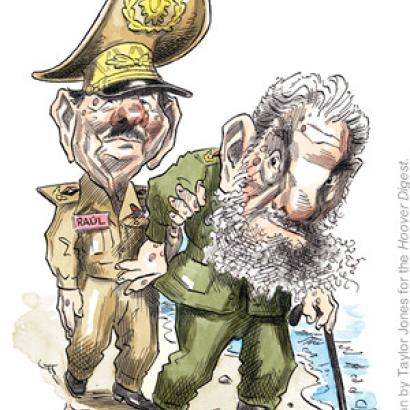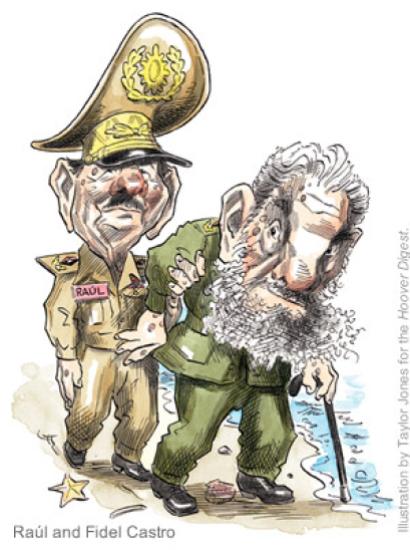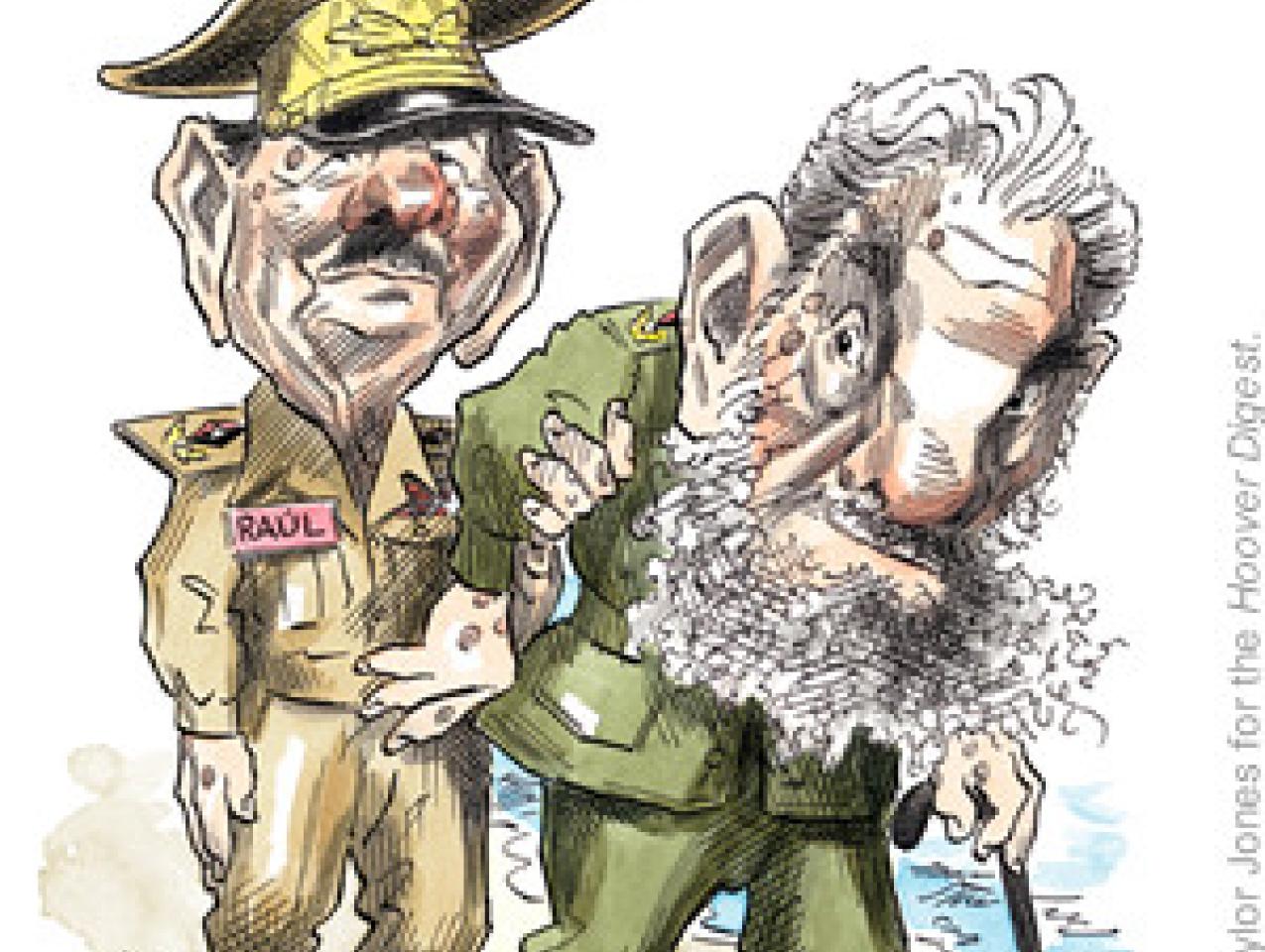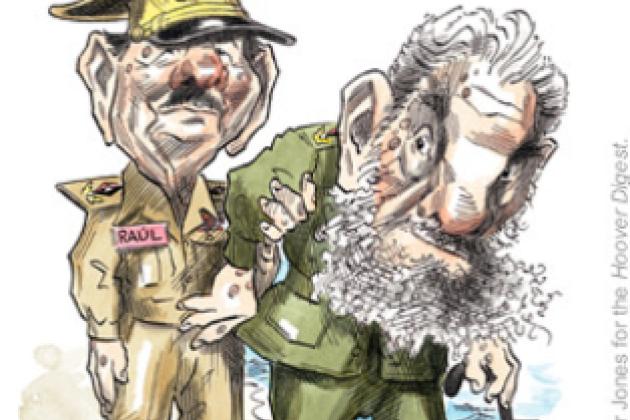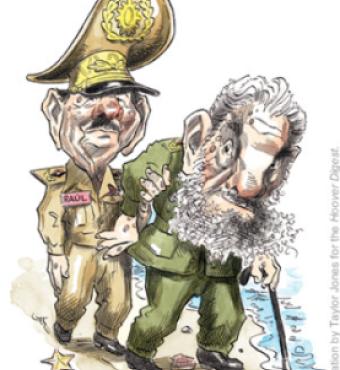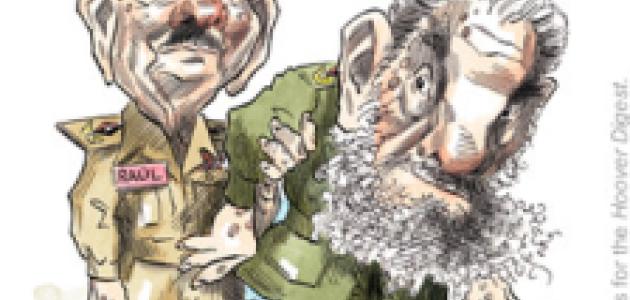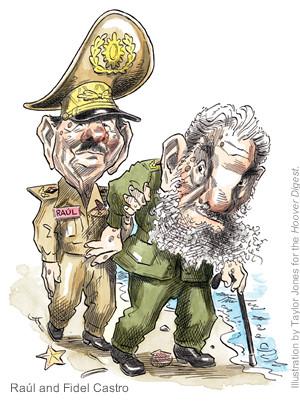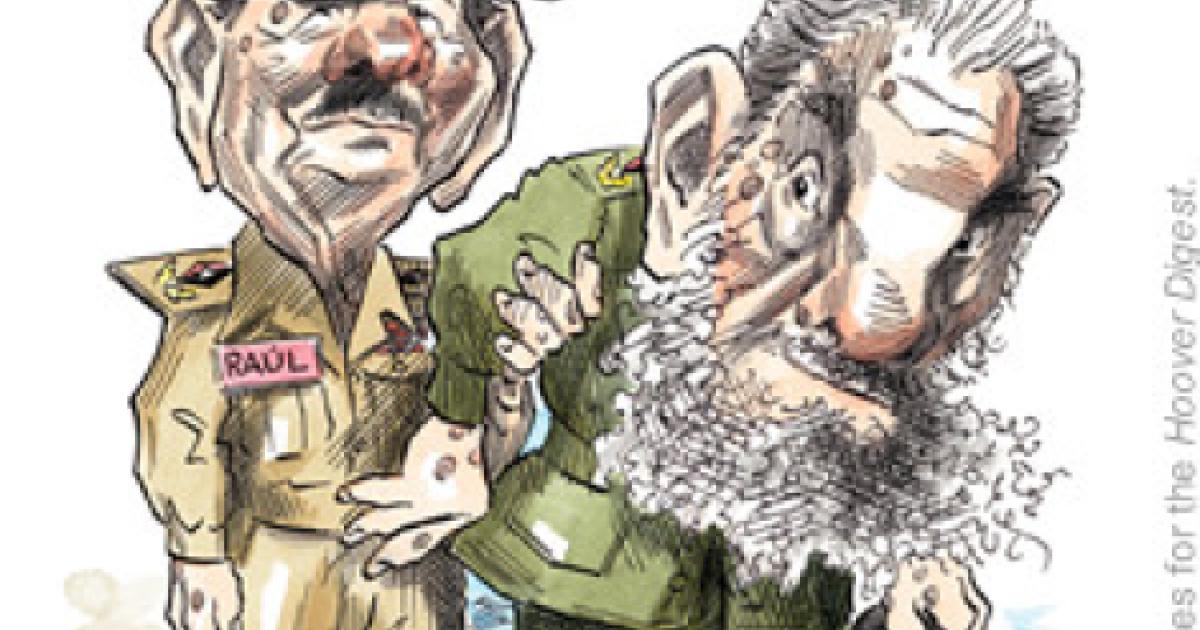- International Affairs
- History
- Contemporary
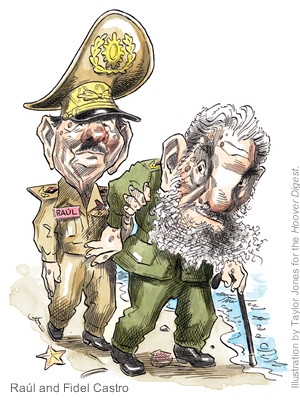
The chorus began as soon as the Soviet Union fell: “Fidel Castro Is History!” The standard argument that the Cuban dictator could not long survive without the massive aid he had received for decades from Moscow was contained in a book entitled Castro’s Final Hour. Well over 100,000 hours have passed since that book was published in 1992, and, with Fidel still raging on, analysts now usually couch their discussions of his eventual demise more modestly, in terms of Cuba’s post-Fidel “transition” (whenever it may come).
Most American (including Cuban American) analysts look forward to a time when Cuba will have a democratic government and a vibrant market economy. But estimates vary considerably on how or when that goal will be reached.
The best-known dissident on the island today, Oswaldo Paya Sardinas, has called for a step-by-step transition to greater popular representation beginning now. Paya outlined his ideas in his detailed “Transitional Program,” which was informally released in Cuba in December 2002. In March and April 2003 Castro responded to this and an increasingly active dissident movement with his most brutal wave of arrests and imprisonments in decades, demonstrating that obstacles to gradual reform remain formidable.
In May 2004 the Bush administration’s newly established Commission for Assistance to a Free Cuba published a program described as a “proactive, integrated, and disciplined approach to undermine the survival strategies of the Castro regime and contribute to conditions that will help the Cuban people hasten the dictatorship’s end.” In hundreds of pages, it laid out steps to that end, ranging from sharply curtailing Cuban American remittances and travel to Cuba to increased support for dissidents on the island. Some of the steps were being implemented by the end of the June.
If there is an immediate move toward democracy after Fidel goes, as envisioned by some in the States, including many Cubans living abroad, then new Cuban leaders may draw some lessons from the experiences of post-Franco Spain and several Eastern European countries that have recently moved from authoritarian to democratic systems. I think it is more realistic to expect the island to remain for some time under some kind of authoritarian control, an expectation I share with many top scholars, intelligence analysts, and defectors.
The Survivor Regime
Assuming some version of authoritarian control in a post-Castro Cuba, there are several strategies Fidel’s survivors may adopt and the Bush administration hopes to thwart. The following is not a blueprint of what I would like to see happen in Cuba in the early years following Fidel Castro’s departure. Rather, it is an examination of what Cuba’s immediate post-Fidel government is most likely to do and what the consequences of its choices and policies may be. All such speculation is constrained by the fact that we do not know when Fidel will finally depart the scene, who will be in position to take power, or what domestic and international conditions the new leadership will inherit. What we can anticipate with some certainty is that Fidel’s successors will inherit a decrepit economy and a volatile society.
The survival strategy discussed here is the possible Cuban adaptation of some of the ideas and experiences of the past quarter-century in China. In sharp contrast to Chinese leaders and analysts during the Maoist decades, the Chinese today do not recommend a “Chinese model” for Cuba or any other country. During Raúl Castro’s visit to China in 1997 then-premier Li Peng remarked that “China’s experience can only be taken as a reference as every socialist country has its own conditions.” In the broadest of terms the Chinese model (or learning from China) might be defined as the promotion of primarily export-oriented, market-style domestic economic reforms by means of programs and institutions that are guided by a largely authoritarian government that continues to proclaim itself socialist.
During the past 15 years, important members of the Cuban political, military, and business elite, including Fidel and Raúl Castro and two-thirds of the members of the Communist Party Politburo, have visited China and remarked with great interest on the Chinese reform experience. A former high-level Cuban intelligence official, Domingo Amuchastegui, has said that after the younger Castro’s visit to China, Zhu Rongji, the chief architect of China’s economic reforms, sent one of his chief aides to Cuba, at Raúl’s request, where he “lectured hundreds of Cuban executives and leaders, causing a tremendous impact.”
Fidel Castro will leave Cuba in a terrible political and economic mess, just as Mao Zedong left China when he died in 1976, and Castro’s successors will be sorely taxed just to retain power. If post-Fidel governments are to remain authoritarian for some years, their political or military leaders, or both, will need to understand that although the Cuban people put up with abject poverty under Fidel, they will not long tolerate such conditions under any other leader. This poses a daunting challenge to future leaders because on the one hand they will have to undertake substantive reforms to simply retain power; on the other hand, the opening process itself may create so many demands that the new leadership will be overwhelmed. Still, in one form or another, authoritarianism has the edge over democracy for the immediate post-Fidel period.
One might ask why reforms have not been launched already. The answer is that, although Fidel has visited China, he is far closer in his ideas and policies to Mao Zedong than to any Soviet leader, never mind any post-Mao Chinese leader. Castro’s alliance with the Soviet Union during the Cold War, and his often very strong criticism of China, was based almost entirely on his need for Soviet-bloc money, arms, and a nuclear shield during his conflict with the United States.
Like Mao, Fidel cannot abandon his old ideas at the end of his life without admitting that his career was a terrible mistake. So just as Mao held on to his egalitarian socialism until the very end, Fidel remains steadfast and allows private initiative only periodically, when the economy is in a particularly disastrous condition. The most recent period of crisis was during the early 1990s, after the collapse of the Soviet bloc. Suddenly Cuba was left without the massive aid and credits that for decades had amounted to about 30 percent of the Cuban GNP. When the worst of a crisis passes, however, Castro usually begins again to harass, restrict, or outlaw private initiative, even in the black market, which is more difficult to control.
At the same time, although Castro will never tolerate Chinese-style market reforms, he has provided “theoretical grounds” for such changes when he is gone, which is more than Mao ever did. One example is Castro’s attitude toward Deng Xiaoping. When Deng took power in the late 1970s, Castro called him a “numbskull” and a “caricature of Hitler.” But when Deng died in 1997, Castro referred to him as “an illustrious son of the Chinese nation” who had made a “valiant contribution to the consolidation of socialism in China.” Thus, although Castro will never undertake Deng’s market-oriented reforms, future Cuban leaders can argue that Fidel accepted them as “consolidating socialism” in China, so why not in Cuba too?
And Cuba’s post-Fidel leaders are likely to follow that lead. As Alcibiades Hidalgo, Raúl’s former top aide and a former U.N. ambassador, told me in 2003, the younger Castro “has sympathized for many years with change in the Chinese style, that is, capitalism or something like it in the economy but a single party and repression of politics.” Former intelligence official Amuchastegui added, “Once Fidel Castro is out of the game, other areas of the Chinese experience [other than the role of the military] will most probably be implemented in Cuba rather quickly.”
Potential lessons from the Chinese experience include the following:
• Cubans need to adopt a new way of thinking, different from both the egalitarianism of the Castro decades and the paternalism of the colonial centuries. Despite the proven business prowess of many Cuban Americans in Miami, this may be the most difficult lesson of all. Several Cuba specialists at the Chinese Academy of Social Sciences emphasize that first and foremost Cuban leaders and people need to jettison stifling egalitarianism and turn instead to promoting initiative, market productivity, and growth. They argue that when government policies encourage individuals and groups—domestic and foreign—who wish to produce, the economy will expand, and living standards will rise for most Cubans, as they have for the majority of the Chinese. The fact that Chinese leaders and people have made this change so successfully, given their long traditional and Maoist history, might in itself be considered an inspiration to Cubans.
One important aspect of this change in thinking relates to the overseas Cuban community. The overseas Chinese were critical to China’s reform process in that they quickly returned to China, took advantage of the opportunities, and adapted to the limitations of the new system. Overseas Cubans, particularly in America, are numerous, and many are wealthy, highly skilled, and well connected. They could make a major contribution to development in Cuba even during a post-Fidel authoritarian period, should Cubans on the island and abroad decide to cooperate and commit themselves to economic policies that give all Cubans a chance to work and prosper. At present, most Cubans, wherever they are, do not seem disposed to such cooperation with a post-Fidel authoritarian regime—and current U.S. policy discourages it.
• The model of a successful (so far), peaceful, and orderly succession of leaders within an authoritarian system was initiated by Deng and continued through Jiang Zemin to the current Hu Jintao. Deng, Jiang, and Hu have been largely successful, despite important continuing challenges, because their reforms have benefited a substantial majority of the people. Fidel has designated Raúl as his successor, though the latter lacks charisma and may not live long enough to take power. Cuba does not seem to have an internal process for choosing future leaders even within the ruling bureaucracy, as was the case in China under Mao.
• China achieved the longest period of double-digit economic growth of any major country in modern history by undertaking economic reforms that promoted (often by simply permitting) initiative, competition, and production among a suppressed but potentially highly creative people. These reforms ranged from the wholesale transformation of current institutions and practices to the encouragement of private shops and industries of all sizes. Many of the changes are enumerated by Carmelo Mesa-Lago in his Growing Economic and Social Disparities in Cuba (2002), published by the Cuba Transition Project, a program at the University of Miami that examines conditions in Cuba today and the many reform possibilities that lie ahead after Fidel Castro is gone. After reading Mesa-Lago’s list of economic reforms, a prominent Chinese analyst noted that all of the economic recommendations are possible and desirable. “But,” he reiterated, “the most important thing is not specific measures, but a changing of the traditional mentality among the people.”
• The Chinese People’s Liberation Army (PLA) was for some years a major player in Chinese economic development. The Cuban Revolutionary Armed Forces (FAR) are already much involved in the Cuban economy, though not yet so broadly as the PLA was in the early 1990s. Because the FAR is the most relatively efficient and highly trained institution in Cuba, the prospects are that its role will expand in the foreseeable future. The negative qualities of the Chinese experience, ranging from corruption to loss of institutional focus, are also already evident in Cuba. In time, Cuba may want to examine how in recent years the Chinese have reduced the PLA’s involvement in economic activities not related directly to the military sector.
• One of the critical unanswerable questions today is what the Cuban military and police would do in the event of a major uprising against Fidel (which is unlikely) or his successor. Deng Xiaoping’s conviction that stability is essential for steady economic growth under authoritarian guidance was demonstrated by the Tiananmen repression of June 4, 1989, in Beijing and other cities. Fidel Castro approved of Deng’s use of the military in that crisis, but it is unclear to what degree the Cuban police or military would follow the PLA example.
Conclusion
The types and timetables of reforms in Cuba are impossible to predict with certainty. Since the end of the Cold War, the U.S. government has repeatedly tightened the embargo, the first two times (1992 and 1996) with the essential support of President Bill Clinton. Now, under George W. Bush, the executive branch is promoting a more integrated and proactive involvement in the hope of speeding up and molding changes in the country. If current U.S. efforts to strengthen Cuban civil society succeed, perhaps at least in the post-Fidel period the current “silent majority” of Cubans, who up to now have been united only in their determination not to rock the political boat, will be able to advance the cause of democracy and free markets. So far, however, the main consequence of the Bush administration’s more activist approach seems to have been the “retaliatory” mass arrests of March–April 2003, which decapitated the democratic opposition on the island.
If Cuban developments in the short and middle term follow trajectories at times observable on the island, they are likely to move slowly toward an open society. That movement is likely to be manifested first in economic reforms, as Cuba’s future leaders examine their obvious needs and apply ideas gleaned from the Chinese or Vietnamese authoritarian models. Such a movement would be positive, even if more gradual than quick democracy, both for the economic well-being of the Cuban people and for the island’s step-by-step entry into the modern world.








